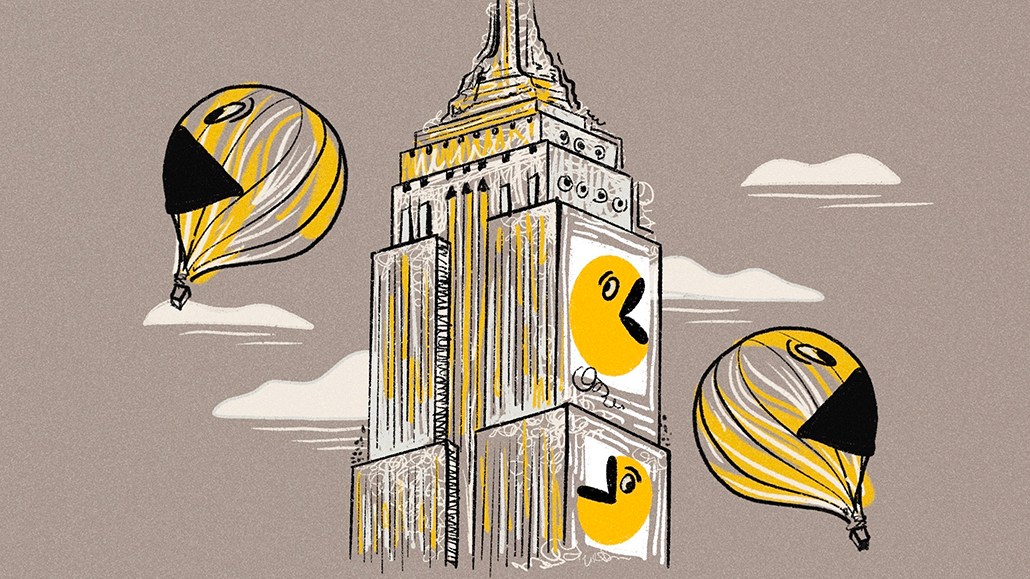Save 50% on a 3-month Digiday+ membership. Ends Dec 12.
Media Buying Briefing: Media.Monks on the trouble, and upside, with advertising in gaming

This Media Buying Briefing covers the latest in agency news and media buying for Digiday+ members and is distributed over email every Monday at 10 a.m. ET. More from the series →
If brands can unlock a deeper level of understanding and integration into the massive and broad world of gaming, there’s an audience there that’s hard to find across the rest of the media and content landscape.
The potential, in other words, is enormous — mobile gaming alone has grown to nearly $7 billion, according to InsiderIntelligence.
However, the gaming world also holds tremendous risk for the brand (or its agency) that goes about marketing their message in a way that feels inauthentic or ill-fitting to the environment. Gamers are notorious for unleashing public anger at any who don’t hold true to a game or a platform’s core values. No marketer wants to get flamed by gamers, because it can burn badly.
Which means media agencies are working double time to seek out the right opportunities for their clients to get involved. That’s a full-time job for Funs Jacobs, senior director of innovation at Media.Monks, and svp of innovation Lewis Smithingham.
“I strongly believe that gaming is the most important place to be for brands in general,” said Jacobs, who’s based in Amsterdam. “And it’s having massive impact.”
Smithingham, who is based in the tech hotbed of Raleigh, N.C., described the gaming business as “so exponentially larger than any other entertainment industry, it makes the movie industry look like a hobby.”
Digiday spoke with Smithingham and Jacobs to get their take on how this space will grow and evolve around marketing efforts. The conversation has been edited for space and clarity.
How are marketers changing the way they pitch getting into games?
Smithingham: The gaming space is driven by authenticity and driven by a sort of feeling that it’s been maligned historically by traditional spaces. It falls into this space where people say ‘Oh, they’re not doing it,’ or ‘They’re not advanced enough.’ But this is already happening — the Lego games are a gigantic franchise that already exists. There’s Lego Star Wars, Lego Batman, you have massive Lego partnerships.
That authenticity is what matters within these spaces. And when you start looking at adding to the surface area of global ad inventory, it’s totally a space that will be built into. However, because of the authenticity, it’s not a space where shitty billboards are going to pop up.
At the same time, while playing a free game, I drove my Porsche, my character was in full Wu Tang Clan gear with Jordans and my emote was a Metallica song — all things I paid for other than the car. All of those things are marketing.
Advertisers want to reach young people who are not watching TV anymore. What kind of marketing can happen that goes beyond these kinds of intrinsic cultural moments?
Smithingham: My favorite video game of all time is Chex Quest. There was a golden era of video game marketing in the mid 1990s, that as a child I absolutely took part in. Chex Quest occurred because the head marketers for Chex called up the makers of Doom and said, ‘Hey, can we license the engine for Doom, please.’ And the maker of Doom said, ‘That’s a stupid idea, but sure, whatever, I’ll take your money.’ And they reskinned Doom where a Chex cereal character runs around shooting milk at boogers. And as a seven year old who was not allowed to play Doom, I absolutely loved it and played the hell out of it. And to this day as a 37 year old, if I see any Chex product, my brain immediately goes to Chex Quest.
Brands have this obsession with exclusivity, and that’s frankly not how anyone’s pantry works. Consumers buy different things because they have different fandoms.
Jacobs: That’s how we started every conversation with every brand — you need to bring value to this community first before you can go after ROI. We’re very used to linear TV, where we put on an ad, we pay for that and we get a certain amount of revenue from that. But when we talk about advertising in game, it’s way more complex. In order to get people to buy a product, you need to bring value first.
That’s exactly what this brand did with Lewis, because they brought him an awesome game, without maybe even making money out of the game. But for the rest of his life, he’ll buy the brand, because he has a good affinity with the brand — because they brought him fun times.
So the business side of gaming companies isn’t trying to muscle advertisers into games, from your perspective?
Jacobs: A lot of brands are trying to get into these games in the right way, especially the big ones. But they have to be a little bit protective so it doesn’t turn into mayhem. Lewis touched upon self expression — if we talk about younger audiences, it’s so important for them to be able to self express in these virtual environments of games. If your brand is not there … If I’m a big fan of Bose headphones, and I spent so much time in this video game, I want to also show that I wear these headphones.
Smithingham: The whole purpose of upfronts or newfronts, depending upon which one you prefer to attend, is to show ‘Here’s our new content inventory that will attract viewers to watch your advertisements.’
The inverse is, Fortnite is already a $17 billion company on a free game. So advertisers coming into there need to add value to the users, and add expression and opportunity — and not intrude or destroy. So frequently, I have conversations where a brand says, ‘When they use our product, I want them to have a power up.’ No, you just intruded on the game. That doesn’t work, that’s not part of the story. That intrusion is the difference.
And the problem that I think a lot of brands and advertisers run into is, this is an industry that doesn’t immediately need them or in some cases want them, unless they’re providing value and opportunity. Is it rad to drive a Porsche in Fortnite? Yes. But I’m sorry, Porsche, you have to be okay with the fact that I just ran over three people.
Color by numbers
The shopping season is here, and social video intelligence platform Tubular and analytics firm Chartbeat published the latest insights on reaching consumers this holiday. Hint: Home in on social channels – because holiday content during this time has already surpassed 2022 by more than 1 million videos across social media apps. — Antoinette Siu
More stats:
- YouTube views jumped 6.5 billion year-over-year. Holiday DIY and decorating content on the video platform increased 75% compared to 2022.
- Videos lasting up to 30 seconds made up the biggest share of holiday DIY/decorating videos last year, but now one- to two-minute video views have surged more than 1,500% year-over-year.
- In 2022, Black Friday mobile traffic spiked 59% from 11 a.m. to noon and peaked at 3 p.m. Search traffic peaked at 9 p.m. on Thanksgiving.
- Don’t forget about the guys: While many brands market to female shoppers over the holidays thinking they make more purchasing decisions, Tubular data saw that men actually make up the majority of holiday gift guide viewers on the social apps.
Takeoff & landing
- Dentsu announced yet another global restructure amid poor Q3 results. Yuichi Toyoda becomes Global Practice president of business transformation, while Jeff Greenspoon becomes Global Practice president of integrated solutions. Both report to Global Practices president Jean Lin. Meanwhile, the holding company downgraded its estimates for organic growth from -2% earlier this year to -5%, while regions underperformed for the quarter (-6.6% in the Americas, -17.2% in EMEA and -9.1% in APAC outside of Japan).
- Brandtech Group’s Jellyfish unit absorbed Acorn-i, an Amazon specialty e-commerce agency, to create Jellyfish Commerce, a platform-first digital commerce and retail media operation that blends content, commerce, and community.
- IPG’s Mediahub landed media duties, including strategy, planning, activation and measurement for Dow Jones, which includes The Wall Street Journal, Barrons and MarketWatch, among others.
- Court Avenue landed direct AOR duties for the U.S. Air Force’s Rapid Sustainment Office, which looks out for the latest tech advances. The agency has been doing project work with the client, which led to the AOR assignment.
- Personnel news: Suzy Ryder was promoted to CEO of OMD U.K., up from chief digital officer. She succeeds Laura Fenton, who was promoted to CEO of Omnicom Media Group U.K…Kirk McDonald, who’s leaving his post as CEO of GroupM North America at the end of this year, was named to the board directors at Ziff Davis…The Mars Agency hired Victoria Cromie to be managing director of its Toronto office.
Direct quote
“While the entire agency services category is weathering headwinds like reduced marketing spend, stalled DX transformation projects and commoditized content/creative offerings, Dentsu’s performance illustrates executional shortcomings rather than an indictment of the company’s strategy. The moves to consolidate brands and services, strengthen the creative offering, invest in technology and production via the TAG acquisition and integration with Content Symphony are strong strategic moves to deliver their end-to-end transformation and marketing solutions. The shortfall is in the execution, which explains what can only be characterized as cleaning house at the global level. Dentsu made a significant upgrade in the appointment of Michael Komazinski as U.S. CEO. The moves in Japan and at the global level are likely designed for similar effect at an executional level.”
— Jay Pattisall, vp and senior agency analyst at Forrester, on Dentsu’s restructuring efforts (see above).
Speed reading
- Ronan Shields addresses the twists and turns of the Department of Justice’s antitrust trial against Google, raising the possibility that the DOJ might actually win, thanks to some material slip-ups by witnesses.
- Antoinette Siu looked at a study out of IPG’s Magna and Acxiom units that showed how first-party data used alongside third-party data can lead to better insights and wider audience reach.
- And I wrote about how Media.Monks converted a project around in-housing with client ManuLife into a full-fledged offering.
More in Media Buying

Nexxen is latest programmatic player to widen TV’s live sports window
The DSP/SSP company wants to make it easier for buyers to funnel budgets from smaller brands into live sports TV ad avails.

The case against AI agents for programmatic ad buying
Hallucination and latency are two main reasons against incorporating AI agents in programmatic ad buying, though there’s still a place for AI agents in programmatic workflows.

Ad Tech Briefing: Platforms’ measurement transparency moves into view
Zefr plans to make viewability free to advertisers in the industry’s walled gardens amid growing calls for more thorough verification.








